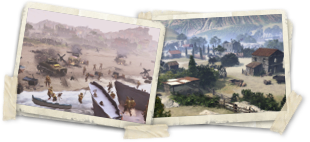
Experience it in game
Play through the battle yourself in the immersive Company of Heroes 3 campaign.
 Experience the dynamic campaign in game with
Experience the dynamic campaign in game with 
 Find out more
Find out moreThe abbey of Monte Cassino in Italy was the stage for one of the most infamous battles of attrition in history, with the Allies facing a formidable Axis defence during WW2.
The incredibly tough climb to reach the hilltop at Monte Cassino, where the Germans made their stand, provided perils of many different kinds.
140,000 Soldiers
24,000 Mines
1,100 Tanks
70 Mortars
520m Tall Hill
46m High Walls
“The Allies had a massive advantage in aircraft and in tanks, but these were completely worthless because of the mountain roads with bridges, easily destroyed by the retreating Germans, who did so with huge efficiency – laying mines, destroying bridges, blowing up mountain roads. One of the Allied commanders actually said ‘a mule is worth five tanks’.”
- Matthew Parker

 Experience the battle for yourself
Experience the battle for yourselfDownload the game now and see how the battle unfolded
©Relic Entertainment. All rights reserved. Developed by Relic Entertainment. Entertainment, the Relic Entertainment logo, Company of Heroes and the Company of Heroes logo are either registered trademarks or trademarks of Relic Entertainment. Relic Entertainment is registered in the U.S. Patent and Trademark Office. All other trademarks, logos and copyrights are property of their respective owners.